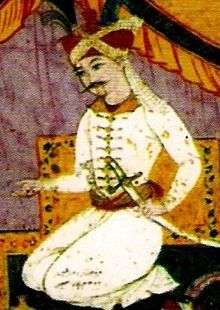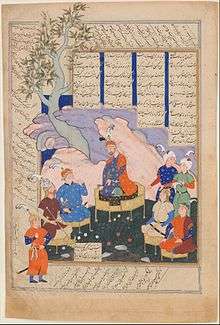Ismail II
Ismail Mirza (Persian: اسماعیل میرزا) later known by his first dynastic name of Ismail II (شاه اسماعیل دوم) (31 May 1537[1]– 24 November 1577) was the third Safavid Shah of Iran, ruling from 1576 to 1577.
| Ismail II | |
|---|---|
 Artwork of Ismail II | |
| 3rd Safavid Shah | |
| Reign | 22 August 1576 – 24 November 1577 |
| Predecessor | Tahmasp I |
| Successor | Mohammad Khodabanda |
| Born | 31 May 1537 Qom, Iran, Safavid Empire |
| Died | 24 November 1577 (aged 40) Qazvin, Iran |
| Burial | Imamzade Hossein, Qazvin, Iran |
| Spouse | Pari Peykar Khanum |
| Issue | Shoja al-din Mohammad Mirza Safieh Sultan Begum Fakhr-i-Jahan Khanum Gowhar Sultan Khanum |
| Dynasty | Safavid |
| Father | Tahmasp I |
| Mother | Sultanum Begum |
| Religion | Sunni Islam |
Early life

Ismail was the son of Shah Tahmasp I by an Iraqi Turkoman mother from the area of Mosul, Sultanum Begum Mawsillu.[2] In 1547, he was appointed governor of the province of Shirvan where he led several expeditions against the Ottomans. In 1556 he became governor of Khorasan but one of his father's leading courtiers, Masum Beg Safavi, convinced the shah that Ismail was plotting to overthrow him. Ismail spent the next 20 years in the prison at Qahqaheh Castle.[3]
On 18 October 1574, Tahmasp became ill—during his illness, he was close to dying two times, and he still hadn't chosen a successor. Thus the main chieftains of the Qizilbash arranged a meeting to discuss about who should be the successor. The Ustajlu clan, and the Shaykhavand clan (which was related to the Safavid family) favored Haydar Mirza Safavi. The Georgians also supported him, since his mother was Georgian.
The Rumlu, Afshar, and the Qajar clan favoured Ismail, who was still jailed in the Qahqaheh Castle. Tahmasp's favorite Circassian daughter Pari Khan Khanum also favoured him.[4] While Tahmasp was still ill, those who supported Haydar Mirza, sent a message to the castellan of Qahqaheh Castle, named Khalifa Ansar Qaradghlu. They requested him to have Ismail killed. However, Pari Khan Khanum managed to find out about it and told Tahmasp about the plot. Tahmasp, who still had some feelings for Ismail due to the courage he used to have in the battles with the Ottoman Empire, sent a group of Afshar musketeers to the Qahqaheh Castle to protect him.[4] Two months later, Tahmasp recovered from the life-threatening illness he had. Two years later, on 14 May 1576, he died in Qazvin. Haydar Mirza was the only son who was with him when he died, and thus the following day, he announced himself as the new king. Normally, some Qizilbash tribes would guard the royal palace and take turns with other others—unfortunately for Haydar Mirza, on that day all the Qizilbash guards were either from the Rumlu, Afshar, Qajar, Bayat, or the Dorsaq tribe—all loyal supporters of Ismail.[4]
When Haydar Mirza found out about the dangerous position he was in, he took Pari Khan Khanum (who was also in the palace) "into custody as a precautionary measure" (Parsadust).[4] Pari Khan Khanum then "threw herself at her brother's feet in the presence of Haydar Mirza's mother", and tried to urge him to let her leave the palace, stating that she was the first to acknowledge his rule by making a prostrating to him—she vowed that she would attempt to persuade Ismail Mirza's supporters to change their mind, which included her full brother Suleiman Mirza and uncle Shamkhal Sultan. Haydar Mirza accepted her request, and gave her permission to leave the palace. However, after she left the palace, she broke her oath and gave Shamkhal the keys to the gate of the palace.[4]
When the supporters of Haydar Mirza found out about the threat their king was in, they hurried to his royal residence to save him. However, the palace guards, who disliked Haydar Mirza (although he had tried to win them to his side by making several promises) closed the entrances of the palace.[4] At the same time, the supporters of Ismail Mirza, entered the palace and went to its inner part. However, Haydar Mirza's supporters shortly managed to break through the gate, but did not reach there in time—Ismail Mirza's supporters found Haydar Mirza, dressed as a woman in the royal harem. He was immediately captured and beheaded.[5] His bloody head was then thrown down to Haydar Mirza's supporters, who stopped their resistance, which thus meant that Ismail Mirza could safely ascend the throne.[4] During the dynastic struggle between the two brothers, Pari Khan Khanum became the de facto ruler of the state;[4] it was she who ordered all the princes and top-ranking members of the realm to gather at Qazvin's main mosque on 23 May 1576, where a famous cleric named Mir Makhdum Sharifi, read the khutbah in the name of Ismail Mirza, thus confirming him as the new king of the Safavid dynasty.[4]
Ismail Mirza, who was still in the Qahqaheh Castle, was shortly escorted out of the place with thousands of Qizilbash warriors and reached the countryside of Qazvin on 4 June 1576. During the 31 days since the death of Tahmasp I, the courtiers and leaders of the Qizilbash clans had visited the palace of Pari Khan Khanum everyday and according to Iskandar Beg Munshi, "informed her of the urgent business of the realm be it fiscal or financial or to do with politics of the day and nobody had any inclination or dared to disobey her command".[4]
After entering Qazvin, Ismail Mirza did not advance to the royal palace directly since the astrologists had stated that the time was ominous. He thus stayed for 14 days at the house of Husaynquli Khulafa, the leader of the Rumlu clan, and the Khalifat al-Khulafa (administrator of Sufi affairs). Although Ismail Mirza held the title of king, the majority of the Qizilbash commanders and high-ranking statesmen persisted to visit Pari Khan Khanum's palace ordinarily. At the same time, Pari Khan Khanum had managed to organize a remarkable court for herself "where her attendants and ladies-in-waiting acted as if they were serving at a proper royal court" (Parsadust).[4]
Reign

Ismail Mirza ascended to the throne under the dynastic name of Ismail II in 22 August 1576.[6] His 19 years of imprisonment in the Qahqaheh castle had deeply affected him, and thus he was not inclined to allow displays of authority by any other person at his own cost. He announced that it was prohibited for Qizilbash chieftains, commander, and high-ranking officials to enter Pari Khan Khanum's palace. He dissolved the services of her guards and her court attendants and seized an extensive space of properties belonging to her. Moreover, he embraced a cold and non-approachable behaviour when he allowed her an audience.[4] Furthermore, he began executing members of the faction who had opposed him, and also turned on some of his other supporters besides Pari Khan Khanum. He killed or blinded five of his own brothers and four other Safavid princes, including Ibrahim Mirza, so they would be unable to take the throne from him.
Ismail, in his campaigns in the Caucasus, brought another 30,000 Georgians and Circassians captives to Iran, further setting on the program of creating a new layer in Persian society, which was already initiated by his father Tahmasp I.[7]
Described as being a "Sunni in sympathy,"[8] he also implemented a pro-Sunni policy and began reversing the imposition of Shi'ism in Iran (which he ultimately sought to abolish)[9] and appointed Sunni-leaning ulema.[10] One belief is that the aim of his pro-Sunni measures was to strengthen his own internal and external political position by appealing to the still strong Sunni sympathies of the Persian population and to placate the Ottomans.[11]
Having fought so hard to make Ismail II king of the Safavid dynasty, Pari Khan Khanum was now met with lack of gratitude from him. The way she was treated by Ismail II made her hostile towards him, and made her prepare to exact vengeance. On 25 November 1577, Ismail II died abruptly and without any initial signs of bad health. The court doctors, who checked the corpse, suspected that he may have died from poison. The general agreement was that Pari Khan Khanum had resolved to poison him with the help of concubines of the inner harem in retaliation for his bad behaviour towards her.[4]
Ismail was a poet, painter and calligrapher, who supported the arts.[12]
Family
Ismail II married four times;
- Pari Peykar Khanum, daughter of Sayyid Nur-ud-din Nimatullah Baqi Yazdi and, Princess Khanish Khanum, daughter of Shah Ismail I.
- A daughter of Amir Pira Muhammad Khan Ustajlu (at Qazvin, 1567).
- A daughter of Shamkhal Sultan, Governor of Sakki (at Qazvin, 1567).
- A daughter of Amir Husain Khan Sultan Kinislu (at Qazvin, 1567).
Offspring
- Prince Sultan Shoja al-din Mohammad Mirza (b. 16 October 1577 – d. 17 February 1578)
- Princess Safiya Sultan Begum (b. 1555 – d. 3 September 1617)
- Princess Fakhr-i-Jahan Khanum (b. 1577 – d. ?)
- Princess Gowhar Sultan Khanum (b. 1578 – d. 1618)
See also
- Safavid conversion of Iran from Sunnism to Shiism
References
- Ismail II , Dr Manouchehr Parsadoost, ISBN 9643251063, 2003
- Andrew J. Newman, Safavid Iran (IB Tauris, 2004) p. 42
- Savory p. 68.
- Parsadust 2009.
- Blow 2009, p. 20.
- Savory 2007, p. 69.
- Oberling, Pierre, Georgians and Circassians in Iran, The Hague, 1963; pp.127-143
- Sinor, Denis, ed. (1990). Aspects of Altaic Civilization III: Proceedings of the Thirtieth Meeting of the Permanent International Altaistic Conference, Indiana University, Bloomington, Indiana, June 19-25, 1987. Psychology Press. p. 33. ISBN 9780700703807.
- Price, Massoume, ed. (1 January 2005). Iran's Diverse Peoples: A Reference Sourcebook (illustrated ed.). ABC-CLIO. p. 68. ISBN 9781576079935.
- Houchang Chehabi; Rula Abisaab (2006). Distant Relations: Iran and Lebanon in the Last 500 Years. I.B.Tauris. pp. 86–8.
- Andrew J Newman (11 April 2012). Safavid Iran: Rebirth of a Persian Empire. I.B.Tauris. p. 118. ISBN 9780857716613.
- Andrew J Newman (11 April 2012). Safavid Iran: Rebirth of a Persian Empire. I.B.Tauris. p. 47. ISBN 9780857716613.
Sources
- Yves Bomati and Houchang Nahavandi,Shah Abbas, Emperor of Persia,1587-1629, 2017, ed. Ketab Corporation, Los Angeles, ISBN 978-1595845672, English translation by Azizeh Azodi.
- Matthee, Rudi (2011). Persia in Crisis: Safavid Decline and the Fall of Isfahan. I.B.Tauris. pp. 1–371. ISBN 0857731815.CS1 maint: ref=harv (link)
- Babaie, Sussan (2004). Slaves of the Shah: New Elites of Safavid Iran. I.B.Tauris. pp. 1–218. ISBN 9781860647215.CS1 maint: ref=harv (link)
- Newman, Andrew J. (2008). Safavid Iran: Rebirth of a Persian Empire. I.B.Tauris. pp. 1–281. ISBN 9780857716613.CS1 maint: ref=harv (link)
- Savory, Roger (2007). Iran under the Safavids. Cambridge University Press. pp. 1–288. ISBN 0521042518.CS1 maint: ref=harv (link)
- Roemer, H.R. (1986). "The Safavid period". The Cambridge History of Iran, Volume 5: The Timurid and Safavid periods. Cambridge: Cambridge University Press. pp. 189–351. ISBN 9780521200943.CS1 maint: ref=harv (link)
- Parsadust, Manuchehr (2009). "PARIḴĀN ḴĀNOM". Encyclopaedia Iranica.CS1 maint: ref=harv (link)
- Nashat, Guity; Beck, Lois (2003). Women in Iran from the Rise of Islam to 1800. University of Illinois Press. pp. 1–253. ISBN 978-0-252-07121-8.CS1 maint: ref=harv (link)
- Daryaee, Touraj (2012). The Oxford Handbook of Iranian History. Oxford University Press. pp. 1–432. ISBN 0199875758. Archived from the original on 1 January 2019. Retrieved 6 August 2015.CS1 maint: ref=harv (link)
- Blow, David (2009). Shah Abbas: The Ruthless King Who became an Iranian Legend. London, UK: I. B. Tauris & Co. Ltd. ISBN 978-1-84511-989-8. LCCN 2009464064.CS1 maint: ref=harv (link)
- Mitchell, Colin P. (2009). The Practice of Politics in Safavid Iran: Power, Religion and Rhetoric. I.B.Tauris. pp. 1–304. ISBN 0857715887.CS1 maint: ref=harv (link)
Ismail II Safavid Dynasty | ||
| Preceded by Tahmasp I |
Shah of Persia 1576–1577 |
Succeeded by Mohammad Khodabanda |